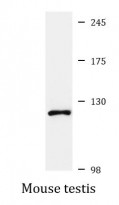ARG58952
anti-RASA1 antibody
anti-RASA1 antibody for Western blot and Human,Mouse,Rat
Overview
| Product Description | Rabbit Polyclonal antibody recognizes RASA1 |
|---|---|
| Tested Reactivity | Hu, Ms, Rat |
| Tested Application | WB |
| Host | Rabbit |
| Clonality | Polyclonal |
| Isotype | IgG |
| Target Name | RASA1 |
| Antigen Species | Human |
| Immunogen | Recombinant fusion protein corresponding to aa. 140-220 of Human RASA1 (NP_002881.1). |
| Conjugation | Un-conjugated |
| Alternate Names | CM-AVM; PKWS; RASA; RasGAP; Ras p21 protein activator; GAP; p120RASGAP; Ras GTPase-activating protein 1; GTPase-activating protein; p120GAP; CMAVM; RASGAP |
Application Instructions
| Application Suggestion |
|
||||
|---|---|---|---|---|---|
| Application Note | * The dilutions indicate recommended starting dilutions and the optimal dilutions or concentrations should be determined by the scientist. | ||||
| Positive Control | Mouse testis | ||||
| Observed Size | 125 kDa |
Properties
| Form | Liquid |
|---|---|
| Purification | Affinity purified. |
| Buffer | PBS (pH 7.3), 0.02% Sodium azide and 50% Glycerol. |
| Preservative | 0.02% Sodium azide |
| Stabilizer | 50% Glycerol |
| Storage Instruction | For continuous use, store undiluted antibody at 2-8°C for up to a week. For long-term storage, aliquot and store at -20°C. Storage in frost free freezers is not recommended. Avoid repeated freeze/thaw cycles. Suggest spin the vial prior to opening. The antibody solution should be gently mixed before use. |
| Note | For laboratory research only, not for drug, diagnostic or other use. |
Bioinformation
| Database Links | |
|---|---|
| Gene Symbol | RASA1 |
| Gene Full Name | RAS p21 protein activator (GTPase activating protein) 1 |
| Background | The protein encoded by this gene is located in the cytoplasm and is part of the GAP1 family of GTPase-activating proteins. The gene product stimulates the GTPase activity of normal RAS p21 but not its oncogenic counterpart. Acting as a suppressor of RAS function, the protein enhances the weak intrinsic GTPase activity of RAS proteins resulting in the inactive GDP-bound form of RAS, thereby allowing control of cellular proliferation and differentiation. Mutations leading to changes in the binding sites of either protein are associated with basal cell carcinomas. Mutations also have been associated with hereditary capillary malformations (CM) with or without arteriovenous malformations (AVM) and Parkes Weber syndrome. Alternative splicing results in two isoforms where the shorter isoform, lacking the N-terminal hydrophobic region but retaining the same activity, appears to be abundantly expressed in placental but not adult tissues. [provided by RefSeq, May 2012] |
| Function | Inhibitory regulator of the Ras-cyclic AMP pathway. Stimulates the GTPase of normal but not oncogenic Ras p21; this stimulation may be further increased in the presence of NCK1. [UniProt] |
| Cellular Localization | Cytoplasm. [UniProt] |
| Calculated MW | 116 kDa |
| PTM | The N-terminus is blocked. Phosphorylated by SRC and LCK. The phosphorylation SRC inhibits its ability to stimulate the Ras-GTPase activity, whereas phosphorylation by LCK does not display any effect on stimulation activity. [UniProt] |
Images (1) Click the Picture to Zoom In






